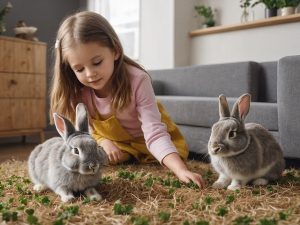Can Rabbits Have Clover Hay? Natural Food & How to Prepare
Opening the Door to the Clover Hay Conundrum
Welcome, fellow rabbit enthusiasts! I’ll be your guide through the lush fields of understanding whether
Let’s Break it Down: What is Clover Hay?
Clover hay is derived from the clover plant, a green, leafy plant that is often seen blanketing serene meadows and countryside with its vibrant colors. Clover hay can come in various types such as red, white, and alsike, each having its distinct characteristics, flavors, and nutrient profiles. It’s not just a treat; it’s an exploration into a world of varied, exciting flavors for our furry companions.

The Heart of the Matter: Can Rabbits Safely Nibble on Clover Hay?
Ah, the essential question, can rabbits partake in enjoying this leafy wonder? The answer is yes, they can! But let’s navigate through this with a keen eye on the quantity, quality, and potential warnings.
Delight or Dilemma: Quantity Matters
Though rabbits can indeed feast on clover hay, moderation is the golden key. While our fluffy companions might dive nose-first into a pile of clover hay with sheer delight, it’s our responsibility to ensure they consume it in reasonable amounts. Small to moderate quantities interspersed with other hay types like Timothy or meadow hay ensures a balanced diet, minimizing risks while maximizing enjoyment and health benefits.
The Bounty of Clover Hay: More Than Just Fiber
Everyone loves a good meal, and for our rabbits, clover hay might just be the gourmet treat they’ve been waiting for. Rich in fiber, clover hay aids in digestion, ensuring that our furry friends’ gut remains healthy. But wait, there’s more! Clover hay isn’t just about fiber; it’s a nutrient powerhouse. Packed with essential vitamins and minerals, it supports a rabbit’s overall health, keeping them vibrant and active. Think of it as a delightful plate of greens that doesn’t just satisfy hunger but also fuels the body.
Beware, For Every Rose (or Clover) Has Its Thorn: Heeding the Warnings
While we’ve sung praises for clover hay, a mindful guardian must also be aware of the caveats. Clover hay, especially if fresh, can contain higher levels of calcium and sugars compared to other hay varieties. Excessive calcium can lead to kidney problems and urinary issues, while surplus sugars can contribute to weight gain and dental issues.
Real Talk: Remember Our Bunny, Roger?
Let’s talk about Roger – a bunny who encountered a hiccup due to an overdose of clover. Roger’s human noticed he was frequently visiting his litter box, a red flag indicating urinary issues. A trip to the vet revealed that the excessive calcium from too much clover hay was the culprit. It was a rocky road, but with a revised diet and expert veterinary care, Roger bounced back. A gentle reminder that while clover hay can be a delightful addition to our rabbits’ diet, it should never overshadow other vital hay types and green veggies.
Seeking Harmony: Introducing Similar and Alternative Foods
While clover hay can be a scrumptious treat and beneficial in moderation, our rabbits will thrive with variety, introducing a symphony of flavors and nutrients to their diet.
Unlocking the Gateway to Other Hays
Diversifying with other hay types like Timothy, Bermuda, and orchard hay prevents boredom and ensures a well-rounded nutrient intake. Each type of hay offers its unique flavor profile and nutritional benefits, making each mealtime an exciting adventure for your rabbit.
Entering the Kingdom of Fruits and Veggies
Closing Thoughts: Embark on a Culinary Adventure with Your Rabbit
Ensuring our rabbits thrive means becoming astute in understanding their dietary needs and preferences. Clover hay can indeed be a delightful and nourishing component of their diet when offered in harmony with other hays, veggies, and occasional fruit treats.
Embrace moderation, celebrate variety, and embark on this culinary adventure with your rabbit, ensuring each nibble contributes to their vitality and joy. After all, isn’t seeing them hop around with unbridled enthusiasm the greatest treasure of them all?
So, dear friends, let’s set forth, ensuring our bunnies not only live but flourish in every hop, skip, and jump, with a diet that’s not just consumed but thoroughly enjoyed.
Note: This article is a generalized guide and not a substitute for professional veterinary advice. Always consult with your vet for specific dietary guidelines tailored to your rabbit’s unique needs.
Clover Hay and its Nutrition for Rabbits
References:
- https://www.feedipedia.org/node/246
- https://riseandshinerabbitry.com/2012/09/09/naturally-feeding-rabbits/
- https://www.sciencedirect.com/topics/veterinary-science-and-veterinary-medicine/rabbit-nutrition
- https://mazuri.com/blogs/education-and-nutrition/choosing-the-right-hay-for-your-rabbit
- https://www.bluemountainhay.com/blog/hay-guide-for-small-pets/







Leave a Reply